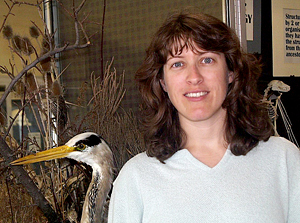Mary Beth Voltura, Associate Professor and Department Chair

Office: Bowers Hall, Room 240
Lab: Bowers Hall, Room 1316
Phone: 607-753-2716
Email: marybeth.voltura@cortland.edu
Education
University of Notre Dame, B.A.
Colorado State University, M.S., Ph.D.
Courses Frequently Taught
- Principles of Biology I
- General Ecology
General Ecology covers concepts in population, community and ecosystem ecology, including ecological genetics, inter-specific relationships such as competition, predation, and herbivory, species diversity, community succession, disturbance and equilibrium, nutrient cycling and energy flow. The laboratory stresses a quantitative approach to ecology, where students conduct experiments and utilize statistical software to analyze their results - Physiological Ecology
Physiological Ecology covers the ecology of individual organisms, with a focus on animals. We examine the physiological adaptations that allow animals to survive and reproduce in challenging physical environments. Examples of specific topics include herbivore response to plant defensive chemicals, hibernation and torpor in cold environments, heat balance and water conservation by desert animals, high-altitude living, energetics of migration, and prolonged diving by marine mammals.
Scholarly Interests
My research centers on the physiological ecology of small mammals; I study how physiological adaptations enable animals to survive and reproduce in the face of environmental stressors. Some of the stressors I’ve examined include poor diet quality, cold ambient temperature and environmental contaminants. My current work focuses on the role of dietary nitrogen for herbivores. Plant nitrogen levels are predicted to decline as atmospheric carbon dioxide levels increase, and the consequences of reduced nitrogen for herbivores are largely unknown. I am conducting feeding trials to determine minimum nitrogen requirements for white-footed mice (Peromyscus leucopus), and studying the role of dietary nitrogen on their growth and reproduction. I have also been working with Dr. Wendy Hood of Auburn University, and Dr. Olav Oftedal of the Smithsonian Institution, on methods for studying lactation in small mammals. Species weighing less than 100 g (e.g. mice and bats) produce very small quantities of milk, and we are currently validating the specialized techniques we developed to ascertain the chemical composition of such small samples.
Selected Publications
-
Hood, W.R, M.B.Voltura, and O.T. Oftedal. In press. Methods of measuring milk composition and yield in small mammals. Chapter 25 in Ecological and Behavioral Methods for the Study of Bats (T.H. Kunz and S. Parsons, eds.). Johns Hopkins University Press.
-
Voltura, M.B. and J. B. French, Jr. 2007. Effects of dietary PCB exposure on reproduction in the white-footed mouse, Peromyscus leucopus. Archives of Environmental Toxicology and Chemistry 52: 264-269.
-
French, J.B. Jr., M.B. Voltura and T.E. Tomasi. 2001. Effects of pre- and post-natal polychlorinated biphenyl exposure on metabolic rate and thyroid hormones of white-footed mice. Environmental Toxicology and Chemistry 20: 1704-1708.
-
Voltura, M.B. and J.B. French, Jr. 2000. Effects of dietary PCB exposure on energetics of the white-footed mouse, Peromyscus leucopus. Environmental Toxicology and Chemistry 19: 2757-2761.
-
Voltura, M.B. and B.A. Wunder. 1998. Effects of ambient temperature, diet quality and food restriction on body composition dynamics of the prairie vole, Microtus ochrogaster. Physiological Zoology 71: 321-328.